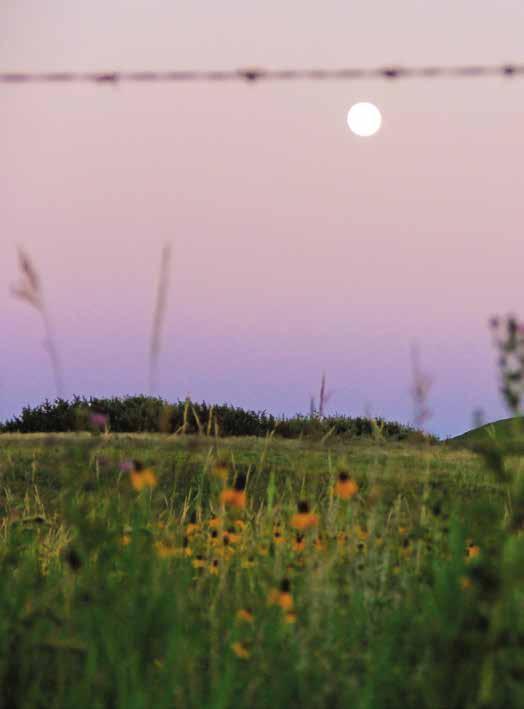
7 minute read
On Completing A Memory
Photo by Jesse Veeder Scofield.
By Taylor Brorby
Advertisement
The earliest memory I have is of death. I’m three, going on four, and am sitting in my grandmother’s Buick, lined with a soft, chocolate brown interior, and waiting for her to see her own mother, my great-grandmother.
Parked outside of a small grey apartment building in Center, North Dakota, the car gently vibrates as I wait for my grandmother to come back to the car. I’m alone, enjoying a juice box, and am looking around, wondering what’s going on.
Why did grandma leave me alone? Maybe it’s a surprise! Maybe she has a present for me!
It is a surprise, but not the one I imagine. My grandma emerges, looking older, haggard, and drawn. She pauses at the front door of her mother’s apartment building, stumbles a bit. She pulls from her pocket her compaq and powders her nose, looking up to the sky to fight back her tears.
I found out later in life that my father had to break into my great-grandmother’s apartment and found her sitting in her green chair with velvet fringes lining the bottom, slumped and cold. The room was cold, I was told; the television was on with a gentle static humming in the background, as if she were just dozing off to take a nap.
I imagine my father’s heart pumping harder and harder as the gentle tic, tic, tics of his knock grows into a crescendo of thump, thump, thump, leading into a climax of, “Grandma, are you in there? Grandma, stand back! I’m breaking in!”
I imagine him breathless, as if he just finished a sprint, hunched over, hands on his knees, eyes pooling with the gentle tears that drip, drip, drip to her cold linoleum floor.
I imagine my grandmother becoming hysterical as my father calls her, trying to tell her that four letter word that struggles to flick from his tongue, that word that lands with a thud: Dead.
My grandma comes back to her 1989 Buick Park Avenue, the one that was bought new from the dealer, which is now two years old, and takes out her compaq yet again and powders her cheeks and nose. I see her quickly flinch, holding back what must be salty tears, trying like steam to escape from a boiling kettle. She clears her throat, and through a strained voice says that we’re about to go to her house so she can talk with Grandpa. She rips at the key to start the ignition, jolts the car forward, as we then come to a glide on our way to her house. The scene looks the same to me—leaves roll in the wind, grass is the same mottled brown. I do not have the sense of self to ask my grandma what has happened, have the sense of perspective to ask her if she needs a hug or a moment to herself to scream. Instead, I play the role of her grandson who is three, going on four, and buckle my seatbelt and look forward to going to Grandma’s house.
---
I remember the basement, its musty smell and unfurling strands of grey-blue smoke. We are at Zion Lutheran Church, a country church, several miles south of Noonan, which is nestled in the northwest corner of North Dakota, gently hugging Montana to the west and Canada to the north. Divide County exists as some faraway land in my memory—like an attic, it is out of sight but not entirely out of mind.
There is must and smoke because this is an old church, and my father, his siblings, and my great-grandmother’s children all smoke. They light up in order to settle down, to help them relax into the fact that their mother, their grandmother, my great-grandmother is dead. I see great-aunts and great-uncles, distant cousins, and my own family sitting in cold steel chairs, struggling to look relaxed in the face of being shaken. I am told I am cute, that I have red hair just like my father, and am bounced on unfamiliar laps. I want to go home.
---
Divide County
It hugs Canada to the north
And lays against Montana’s eastern breast.
A landscape pressed by copper coins
Whose basins are filled with the
Drip drip drip
Of cold grey-blue alkaline water.
Whose landscape haunts the nooks of my memory.
That place where dirt and clay enclose
My great-grandparents.
A landscape that rips at my chest
Leaving my breath beating like a train at the tracks.
---
I never knew them, my great-grandparents. My great-grandfather, the man whose name I bear between my first and last names, died eight years before I was born, and my great-grandmother is wedged into a coffin in my memory. I’m sure I sat on her lap; I’m sure she even gave me birthday and Christmas presents, but in my young life of three, going on four, my great-grandma now exists as an objective fact, rather than a subjective player in the experience of my life.
---
I returned to Zion Lutheran church 22 years later. After teaching creative writing in Powers Lake, North Dakota, I went driving through Divide County, looking for a white country church; the one where I knew my great-grandmother was buried—only, I did not know its name.
I texted my aunt, sister, and father, “Hello from Hamlet, North Dakota,” my great-grandmother’s hometown, now populated with seven people. At the north end of Hamlet sags an empty brick school, what once must have been the focal point of the small town.
Did my great-grandmother go to this school? Did she run through the fields that flow out from Hamlet? Did she pick wild flowers near sloughs and shelter-belts? Did she long to run away, to her own faraway land?
I turned east, driving past numerous pump jacks that flared and fumed natural gas. As I drove, I called my father, asking him where my great-grandmother was buried. (I thought there was a church in Hamlet, which, after driving through the town, I realized there is not.) After listening to my father describe the direction of the church from Hamlet, I headed north on Highway 21.
Divide County is dotted with ponds that look like copper coins have been imprinted into the landscape, filled with azure blue water.
The clouds grew grey and dark, releasing a steady rain that pat, pat, pat on my windshield.
Against the steel blue-grey horizon, Zion Lutheran Church stood white as a bride on her wedding day. I turned left off of Highway 21, heading to the land that holds my great-grandparents.
I ran through the graveyard, searching for the name I so longed to see: Emma Moss. I saw familiar names— Fenster, Fagerland, and Johnson—names that followed the coal boom south to Oliver County in south-central North Dakota in the late 1960s.
I found them, Clinton and Emma, my great-grandparents, in the northwest corner of the churchyard, marked by a copper-colored granite stone. I relaxed my shoulders, breathed the cold autumnal air that was now flecked with the first signs of snow, and I turned to go into the church.
Entering Zion Lutheran Church flooded my memory with must and smoke—but the basement floors were no longer wood—the only real memory I had of the building—and instead were now carpeted.
I went into the sanctuary, greeted by a stained glass picture of Christ kneeling against a large stone, draped in a crimson Roman toga, his sheet-white face turned heavenward as sleeves of gentle white linen wrapped his arms. Mountains dot the background of glass, with billowing thunderheads over Christ’s head. Evergreen florets mark the top of the stained glass, and Greek columns—Corinthian columns—bracket the window panes.
A soft yellow-cream color paints the inside of Zion Lutheran Church, as well as plastered walls filled with florets, four-leafed clover enclosed in a gentle circles, and baseboards of fleur-de-lis that push the eyes towards the altar.
As I entered, I moved to the front and sat at the upright mahogany piano and began to play hymns. A dead mouse lay next to the piano bench.
---
This flow’r, whose fragrance tender with sweetness fills the air,
Dispels with glorious splendor the darkness ev’rywhere.
True man, yet very God,
From sin and death he saves us and lightens ev’ry load.
---
The music lingered like a delicate perfume in the cream-colored interior. I filled the sanctuary with melodies and improvisations, dancing together as the piano created in me a complete patchwork of memories.
---
The ground was stiff and icy as I left Zion Lutheran Church. I looked across the road into a field filled with sloughs and dotted with grey-watered ponds. Pump jacks gently rose and fell, pulling sweet crude oil from deep beneath the earth’s crust. I gently inhaled as I closed the chapel door, smelling the tang of petroleum.
Taylor Brorby is writer-in-residence at Holden Village. His work has appeared in Orion Magazine, the Northern Plains Ethics Journal, Sleet Magazine, Augsburg Fortress Press, among others. He is this year’s Abdelkader Education Project’s essay judge and is currently working on a vespers service for climate change. He is a contributing editor for The EcoTheo Review and writes on education and environmentalism for The Huffington Post.










